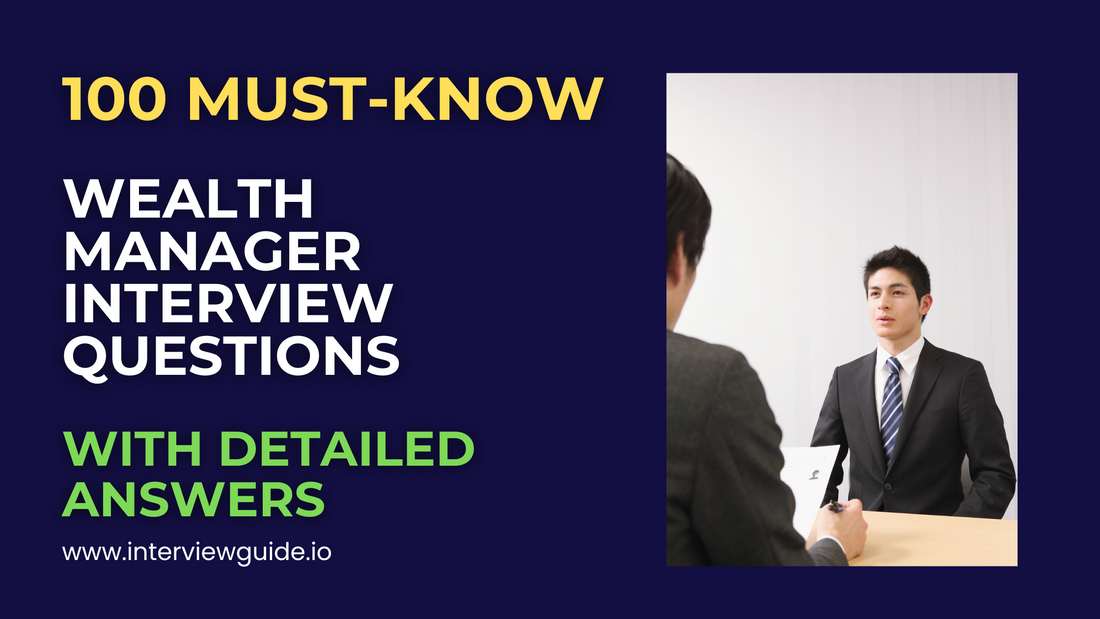
100 Wealth Manager Interview Questions & Answers
Share
Preparing for a Wealth Manager job interview? Whether you’re pursuing a role in private banking, financial advisory, or investment management, it’s essential to know what to expect and how to respond with confidence. Employers are seeking professionals who not only understand portfolio construction, risk assessment, and market trends, but also excel at building long-term client relationships and delivering personalized financial strategies that align with clients’ goals.
In this article, we’ve compiled 100 of the most common Wealth Manager interview questions, complete with example answers to help you prepare effectively. From queries about asset allocation and tax planning to client communication and ethical considerations, this comprehensive guide will equip you with the knowledge and confidence to make a strong impression in your next interview. Let’s get started!
1. What Is Your Approach To Portfolio Construction?
My approach to portfolio construction begins with understanding the client's unique financial goals, risk tolerance, and investment horizon. I prioritize a diversified mix of asset classes, including equities, fixed income, and alternative investments, tailored to the client's specific needs. I utilize strategic asset allocation to balance risk and return effectively, while also incorporating tactical adjustments based on market conditions. Regular portfolio reviews and rebalancing are essential to ensure alignment with the client's objectives and to adapt to changing economic environments. Communication with clients about their investments is a key part of my strategy, fostering transparency and trust.
2. How Do You Determine A Client’s Risk Tolerance?
Assessing a client’s risk tolerance involves a comprehensive understanding of their financial situation, investment goals, and emotional comfort with market fluctuations. Initially, I conduct a detailed questionnaire that addresses their investment experience, time horizon, and financial objectives. Additionally, I engage in discussions to explore their reactions to past market downturns and financial losses. This qualitative insight, combined with quantitative metrics such as income, asset allocation preferences, and liquidity needs, helps me create a tailored investment strategy that aligns with their risk appetite, ensuring they are comfortable with potential outcomes while pursuing their financial goals.
3. What Asset Allocation Models Do You Typically Use?
In my practice, I typically utilize several asset allocation models tailored to individual client needs. One popular model is the Strategic Asset Allocation approach, which establishes a long-term mix of asset classes based on the client's risk tolerance and investment goals. I also employ Tactical Asset Allocation, allowing for short-term adjustments to capitalize on market conditions. Additionally, I incorporate Dynamic Asset Allocation, which adapts the portfolio in response to changing market environments. Each model ensures a diversified approach, balancing risks and returns according to clients' unique financial situations and objectives.
4. Can You Explain Modern Portfolio Theory?
Modern Portfolio Theory (MPT) is a framework for constructing a portfolio that aims to maximize expected return for a given level of risk. Developed by Harry Markowitz, it emphasizes diversification as a key strategy to reduce risk. MPT suggests that an investor can construct an efficient frontier, which represents the set of optimal portfolios offering the highest expected return for a specified level of risk. The theory also introduces the concept of the efficient market hypothesis, indicating that it’s impossible to consistently achieve higher returns without taking on additional risk. Investors are encouraged to consider the correlation between asset classes to further optimize their portfolios.
5. What’s Your Understanding Of CAPM (Capital Asset Pricing Model)?
CAPM, or Capital Asset Pricing Model, is a financial model used to determine the expected return on an investment based on its systematic risk, measured by beta. It establishes a linear relationship between the expected return of an asset and its beta, which reflects the asset's volatility in relation to the market. The formula is expressed as: Expected Return = Risk-Free Rate + Beta * (Market Return - Risk-Free Rate). This model aids investors in understanding the risk-return tradeoff and helps in making informed investment decisions by highlighting the required return for taking on additional risk compared to a risk-free asset.
6. How Do You Evaluate The Performance Of A Mutual Fund?
Evaluating mutual fund performance involves examining several key metrics. First, assess the fund's returns against a relevant benchmark, such as an index that reflects the fund's investment style. Look at both short-term and long-term performance to understand consistency. Next, analyze risk-adjusted returns, utilizing metrics like the Sharpe Ratio, which measures excess return per unit of risk. Consider the fund's expenses, as higher fees can erode returns. Additionally, review the fund manager's historical performance and investment strategy. Regularly monitoring these factors allows for informed decisions regarding fund selection and investment strategy adjustments.
7. What Is The Sharpe Ratio, And Why Is It Important?
The Sharpe Ratio is a measure that helps investors understand the return of an investment compared to its risk. It is calculated by taking the difference between the return of the investment and the risk-free rate, then dividing that by the investment's standard deviation. A higher Sharpe Ratio indicates that an investment has a better risk-adjusted return, meaning it provides more return per unit of risk taken. This ratio is crucial for portfolio management, as it assists in comparing different investments and helps investors make informed decisions by evaluating how well returns compensate for the risk involved.
8. How Do You Stay Current With Market Trends And Economic News?
Staying current with market trends and economic news is crucial for informed decision-making. I regularly read reputable financial news sources such as Bloomberg, The Wall Street Journal, and Financial Times. I also subscribe to various market analysis newsletters that provide insights and expert opinions. Attending industry conferences and webinars helps me network with professionals and learn about emerging trends. Additionally, I utilize financial podcasts and online courses to deepen my understanding of specific topics. Engaging with professional associations and forums allows me to exchange views with peers, ensuring I remain well-informed on market developments.
9. What’s The Difference Between Active And Passive Investing?
Active investing involves a strategy where managers or investors make specific investments with the goal of outperforming a benchmark index. This approach requires considerable research, analysis, and frequent trading, aiming to capitalize on market inefficiencies. Conversely, passive investing seeks to mirror the performance of a specific index by investing in the same securities, typically with minimal trading. This strategy often involves lower fees and reduced tax implications due to less frequent buying and selling. While active investing can yield higher returns, it also carries greater risk and costs, making it essential for investors to carefully consider their goals and risk tolerance when choosing between the two approaches.
10. How Do You Diversify A Portfolio?
Diversifying a portfolio involves spreading investments across various asset classes, sectors, and geographies to reduce risk. One effective way is to include a mix of equities, fixed income, real estate, and alternative investments. Choosing assets that have low correlation can help mitigate losses during market downturns. For instance, when stocks are underperforming, bonds may provide stability. Additionally, diversifying within asset classes, such as investing in both growth and value stocks, can enhance risk-adjusted returns. Regularly reviewing and rebalancing the portfolio ensures alignment with the investor's risk tolerance and financial goals. This strategy fosters resilience against market volatility.
11. Explain How You Would Build A Retirement Plan For A 45-Year-Old Client.
Building a retirement plan for a 45-year-old client involves several key steps. First, I would assess their current financial situation, including income, expenses, assets, and liabilities. Next, I would determine their retirement goals, such as desired retirement age and lifestyle. It's essential to understand their risk tolerance to create an appropriate investment strategy. I would recommend a diversified portfolio that balances growth-oriented investments with more stable options to mitigate risks. Additionally, I would consider tax-efficient strategies, including maximizing contributions to retirement accounts. Regular reviews and adjustments to the plan would ensure it remains aligned with any changes in their financial situation or goals.
12. What Financial Planning Software Are You Proficient In?
I am proficient in several financial planning software tools, including eMoney Advisor, MoneyGuidePro, and RightCapital. Each tool offers unique features that enhance the financial planning process. eMoney Advisor provides extensive client engagement and robust planning capabilities, enabling me to create detailed financial plans. MoneyGuidePro focuses on goal-based planning, allowing clients to visualize their financial futures clearly. RightCapital streamlines tax planning and cash flow analysis, making it easy to demonstrate strategies in real time. Familiarity with these tools allows me to tailor my approach to meet each client's specific needs and preferences.
13. How Do You Evaluate Risk In Fixed Income Investments?
Evaluating risk in fixed income investments involves several factors. First, assess the credit quality of the issuer, which indicates the likelihood of default. This can be determined through credit ratings from agencies like Moody's or S&P. Next, consider interest rate risk; as rates rise, bond prices typically fall. Duration is a key measure here, indicating how sensitive a bond's price is to changes in interest rates.
Additionally, analyze liquidity risk, which refers to how easily an investment can be sold without significantly affecting its price. Economic conditions and market trends are also vital; understanding inflation expectations helps gauge purchasing power erosion. Finally, reviewing the bond's structure, including call features or covenants, offers further insight into potential risks.
14. Describe How You’d Manage A Portfolio During A Market Downturn.
Managing a portfolio during a market downturn requires a proactive approach. First, I would assess the current asset allocation to identify areas of vulnerability. Diversification is crucial; I would ensure that the portfolio includes a mix of asset classes that typically perform well in downturns, such as bonds and defensive stocks. Communicating with clients is essential; I would reassure them, reminding them of their long-term goals and the importance of staying the course. Additionally, I would consider rebalancing the portfolio to take advantage of lower asset prices, potentially adding to positions that align with the client's risk tolerance and investment objectives. Monitoring economic indicators and adjusting strategies accordingly is also vital during this period.
15. What Are Structured Products, And When Would You Recommend Them?
Structured products are pre-packaged investments that typically combine a debt security with a derivative. They offer tailored exposure to various asset classes and can be designed to meet specific investment goals, such as enhanced yield or risk management. I would recommend structured products for investors seeking customized strategies that align with their market outlook and risk tolerance. These products can be suitable in volatile markets or when an investor wants to hedge against specific risks. However, it's crucial to ensure clients fully understand the inherent risks and complexities involved, as well as the liquidity considerations associated with these investments.
Click here to download all 100 questions and answers as a PDF
